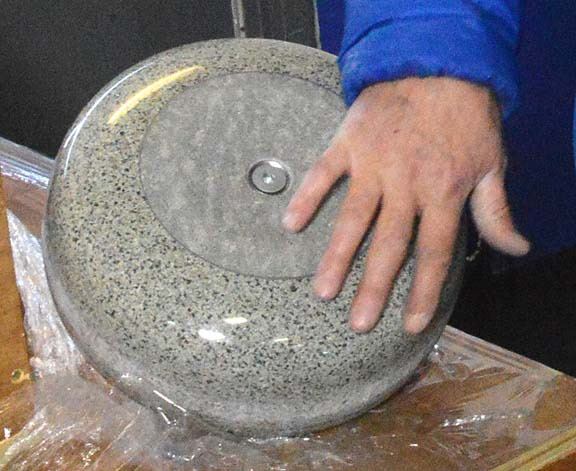Barry Coulter
When the big rocks collide, it’s high drama indeed. Prepare for tectonic shifts in Cranbrook — centre of the curling world for the next week.
Sixty teams are in town for the Pinty’s Grand Slam of Curling, a stop on Sportsnet’s Tour Challenge, and along with the high quality ice, the rocks are of premier importance to curlers, and thus to the fans.
There are two main manufacturers of curling rocks — Kay’s of Scotland and Canada Curling Stone. These two rivals will both be represented at Pinty’s Grand Slam of Curling, which commences in bold fashion Tuesday, Nov. 8, at Western Financial Place, and runs until Nov. 13 at WFP and the Memorial Arena.
Dave Merklinger from Vernon, one of the ice technicians working with Mark Shurek, has done ice for the Briers, the Scotties, and other major events. This is his first Grand Slam, working with his friend icemaker Mark Shurek. Merklinger gave a little tour of one of the stones ready for use — in this case, Kays of Scotland down at the Memorial (Canada Curling Stone are in use at WFP).
He hefts a stone, points out the bottom, where a different colour and kind of granite has been inserted. “This is blue hone granite — the best kind of granite you can get,” Merklinger said. “This is the only part of the stone that touches the ice. Only a ring about one-eighth of an inch on the bottom of the stone actually touches the surface.
Merklinger displays the top and side of the stone. “The outside core, or casing, is of an inferior quality, but it is much better for striking and it’s much better for holding moisture.
“It’s the best of two worlds when they learned how to do this,” Merklinger said.
The forty-pound masses of rock can seem pretty cumbersome an indelicate, but they can be thrown with pinpoint precision. And of course, being the main instrument of their trade, curlers can get pretty finicky about the stones.
“Of course, they’re human, and of course they’ll blame a rock if they think that it’s not reacting the way they think it should react,” Merklinger said. “And nothing’s ever perfect. But they’re generally pretty close.
“But you can actually feel if there’s an inferior running surface (on the bottom of the stone). A little pit here, or a little rough spot there. Curlers can pick that up pretty quick, and they’ll just give it away to the lead — the skip gets the perfect pair. That’s the way it should be.”
The curler’s heightened awareness of the qualities of the rock makes for a potent mix when combined with the superstitions of the athlete. Merklinger has seen a lot in his time in the curling business.
“There are all kinds of superstitions,” he said. “They can go right from the number of the rock they’re throwing. Some curlers don’t like to throw a seven or eight — they like to throw a four or a five. They don’t like to throw yellow rocks, they like to throw blue rocks.”
Sportsnet is travelling with its own tested and calibrated rocks, using both Kays of Scotland and Canada Curling Stone. The rival makers of curling stone both have their own unique quarries in the U.K.
Basementgeographer.com reports that not just any type of granite can be used to make these 17-20 kg (38-44 lb) rocks. With stones crashing against each other repeatedly, over and over again for years on end (20-30 years is a healthy lifespan), an average curling stone sees thousands of such collisions over its lifespan, meaning that the type of granite used has to be extremely durable, non-porous, and shatter-resistant.
Such rock is extremely hard to come to come by, and traditionally the only two suitable types of granite for curling, blue hone and common green, were only found on Ailsa Craig, an island off Scotland. Kays have an exclusive agreement with the island’s owner, the Marquess of Ailsa, to harvest the loose boulders on the island. the most recent harvest removed 1,500 tons of common green and 200 tons of blue hone – enough to make about 8 000 stones, which would be enough to supply 500 rinks.
After searching for years for its own source of high quality granite, Canada Curling Stone now has the exclusive right to harvest granite m the Trefor quarry on the Ll?n Peninsula in north Wales at the Trefor quarry. Not only do but the supply of rock available is far greater. Trefor is more durable than Ailsa Craig blue hone and so is better suited for crashing and banging, but Ailsa Craig blue hone is less porous and better suited for sliding on ice. According to basementgeographer.com, many rinks are moving to a sort of hybrid stone: stones with traditional Ailsa Craig blue hone running band inserts (the smoothest, least-porous type of granite for gliding along the ice) attached to Trefor bodies and strike bands (the middle portion of the stone that collides with other stones) along the outside. A hybrid stone as such can extend the lifespan of the stone to 40-50 years.
“These are beautiful,” Merklinger said the rocks, stacked in boxes at the Memorial, ready to go into action. “The technology that has gone into crafting the stones in the last 20 years is unbelievable.”
Merklinger added that he’s observed an increase in popularity and participation in curling.
“I think with the advent of TV and everything that’s going on — televising the Slams — there’s actually an increase [in curling participation].”
Merklinger managed the Vernon Curling Club, and has seen an increase in membership in the last five years.
“A lot of it has to do with the Olympics. A lot of it has to do with televised events like the Slam. And it’s a fun game to play.”
With files from basementgeographer.com
